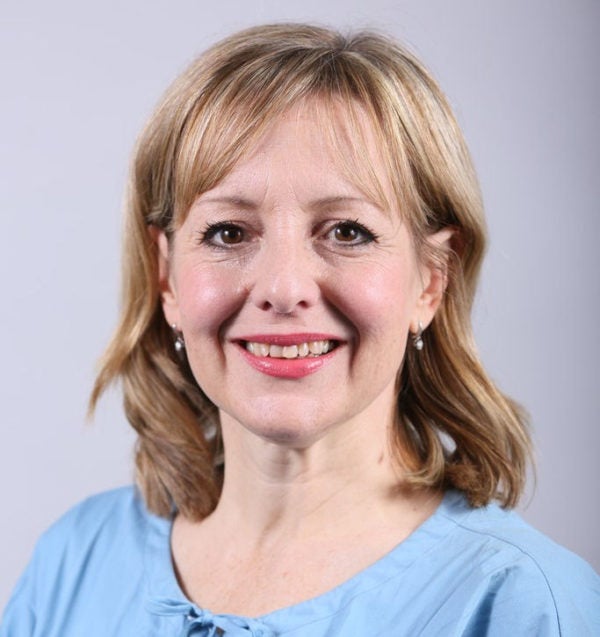
Angela Logothetis is the CTO of Open Network at Amdocs, a telecoms company that specialises in software and services for communications, media and financial services providers and digital enterprises.
She has been at the company for ten years and is a non-executive board director of EXFO, which measures and tests fiber optic. She is also a technology advisor to an ecosystem of technology companies and has become a leading voice in the telecoms industry on topics such as 5G and mobile gaming.

Access deeper industry intelligence
Experience unmatched clarity with a single platform that combines unique data, AI, and human expertise.
In this Q&A, the 23rd in our weekly series, Logothetis explains why the pandemic is accelerating the need for 5G innovation, how true disruption “comes out of the blue” and the question she always asks when assessing the merits of technology.
Rob Scammell: Tell us a bit about yourself – how did you end up in your current role?
Angela Logothetis: I started my career in management consulting and purely by chance, I landed on a telecommunications project, right at the time that both mobile data and fixed-line broadband were being launched in Australia. Do you remember how amazing we thought GPRS/EDGE and ADSL and DOCSIS were? These technologies delivered fast and simple connectivity to the internet – transforming how we accessed and communicated information. I was hooked and it was the start of an amazing career in telecommunications. I have been incredibly lucky to live and work across the globe – launching or transforming telecoms companies in Australia, Malaysia, Indonesia, the Philippines, India, the USA, Canada and my current home, the UK.
I joined Amdocs through the acquisition of a successful startup and re-located to the UK to lead the new business unit. Amdocs is the market leader in customer experience systems and this was the first strategic step toward the network. We identified two trends early on. The first was the need to manage (and now digitise) the engagement and experience all the way from the customer to the network. The second was the transformation of the network from proprietary hardware to open software and cloud. We formed a new Open Network division and I took on the CTO role.
“I also became a non-executive member on the EXFO board after a memorable meeting in a coffee shop at Heathrow airport. I was on maternity leave and the founder and Chairman of EXFO was in London for the day. EXFO is the market leader in fibre optic test and measurement and a market disruptor in network service assurance. The company is enabling rollout of the massive fibre networks critical for 5G, fibre broadband, cloud and edge. And it is doing some really interesting work with data and analytics to measure the quality of the services we rely on these networks to deliver.

US Tariffs are shifting - will you react or anticipate?
Don’t let policy changes catch you off guard. Stay proactive with real-time data and expert analysis.
By GlobalDataWhat’s the most important thing happening in your field at the moment?
5G. Just like no-one could have imagined the way 4G and smartphones would enable the app economy, 5G will enable things we can only just begin to imagine. 5G won’t just change the way we communicate – it will change the way we live and the way we work, the way we engage, socialise, mobilise.
In 2019, the race was on to build and launch the world’s first 5G networks. 46 service providers across 18 countries launched commercial networks. We expected the race to intensify in 2020. But now, as well as racing to build networks, I expect we will see a race to launch innovative 5G services. Covid-19 is accelerating demand and will validate the feasibility and business case for a number of 5G services that we all thought were still some way off into the future.
Which emerging technology do you think holds the most promise once it matures?
It is not just one technology – but a raft of technologies maturing at the same time – 5G, software-defined networks, cloud-native, edge computing, AI and machine learning (ML), as well as a whole raft of new consumer and enterprise devices – AR and VR, smart glasses, folding screens, robotics, self-driving vehicles.
Our industry has been exploring some of the many possible innovations when these technologies are combined. But no one has been sure of which innovations will succeed and most people think we are still very early in the innovation cycle.
However, the unprecedented change in the way we live and work due to Covid-19 is accelerating the need for 5G innovation. Mobile broadcasting, virtual offices, remote education, tele-health, home automation, robotics (anyone for a robotic nanny whilst we juggle working from home whilst educating from home?), automated manufacturing, logistics and transportation are now real issues that the industry is racing to address.
At Amdocs Open Network we are investing in three technologies which we believe will enable these emerging technologies to live up to their promise. Firstly, network orchestration, to scale the network and build capacity when and where it is needed. Secondly, network slicing, to enable delivery of unique SLAs of the new 5G services all on one common 5G network. This would enable a service like cloud gaming to get the low latency it needs, whilst a service like broadcasting will get the high bandwidth it needs, and a smart city will be able to connect hundreds of thousands of devices and sensors – all on the same network. Thirdly, machine learning and automation, to identify and resolve, in near real-time, problems that impact the availability of the network or the quality of the service.
How do you separate hype from disruptor?
I remember someone once said to me ‘disruption will come from places that you aren’t even looking’. I think mainstream transformations, the next wave of business or technology evolution, go through hype cycles. Major vendors and customers and the industry, talk about and play with the technology, often for long periods before it succeeds (if it even does). I think of disruption as technology that comes completely out of the blue from places or people that nobody knew or thought about.
My CTO team looks at technologies in the hype cycle and at the disruption happening in our ecosystem. But we also look for startups and disruptors in unrelated markets and ecosystems as these are the things that may disrupt our industry as a whole.

What’s the best bit of advice you’ve been given?
To ask and understand ‘why now?’. The timing of any transformation or disruption is critical. Not only does the technology need to be ready, but the market, the customers, the ecosystem need to be ready. And more than just being ready, there needs to be a compelling reason why they will act now.
Where did your interest in tech come from?
Maybe as a CTO I shouldn’t say this, but my interest is not in the technology per se, but rather the application of technology that fascinates me. I remember working with a giant telecoms disruptor in India. And they wanted to build a network in a disruptive way to make the price of a phone call cheaper than the price of a postcard so that families in villages could be connected.
What does a typical day look like for you?
The structure of my days are often very different and are dictated by where I am, who I am meeting with and what we have set out to achieve. I try to balance the time I spend externally with our customers and partners and ecosystem with the time I spend internally leading strategic processes, building teams and aligning internal stakeholders.
Every day there is something new to learn and then figure out what it means for our industry, our customers and for us. In an industry that changes so rapidly, it is important to be able to keep your workday fluid, as you never know what you will need to focus on next.
What do you do to relax?
I love being outdoors and teaching my kids new sports. They are already better than me at most things. We are planning to learn to surf this year so maybe I will have an advantage for a year or so whilst they are beginners. If I really want downtime – yoga, a book or a beach – ideally all three.
Who is your tech hero?
I am in awe of the recent generation of technology leaders in Australia. For many years geography was a barrier to success. Australian tech companies would relocate overseas to be closer to capital, talent and markets. Now, we see Australian companies creatively using technology to not only overcome the geographical disadvantage but to use that disadvantage to create and disrupt global markets.”
What’s the biggest technological challenge facing humanity?
As a technology leader, I feel a responsibility to consider the human impact of technologies like AI/ ML and automation, particularly on the future of work.
On a personal level, I am very interested in applying technology to the challenge of climate change. We can use technology to make more sustainable choices in the way we live, the way we travel, the way we work.
Read more: CTO Talk: Q&A with Cervest’s Alex Rahin







